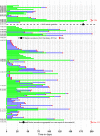Sexual transmission of Zika virus and other flaviviruses: A living systematic review
- PMID: 30040845
- PMCID: PMC6057622
- DOI: 10.1371/journal.pmed.1002611
Sexual transmission of Zika virus and other flaviviruses: A living systematic review
Abstract
Background: Health authorities in the United States and Europe reported an increasing number of travel-associated episodes of sexual transmission of Zika virus (ZIKV) following the 2015-2017 ZIKV outbreak. This, and other scientific evidence, suggests that ZIKV is sexually transmissible in addition to having its primary mosquito-borne route. The objective of this systematic review and evidence synthesis was to clarify the epidemiology of sexually transmitted ZIKV.
Methods and findings: We performed a living (i.e., continually updated) systematic review of evidence published up to 15 April 2018 about sexual transmission of ZIKV and other arthropod-borne flaviviruses in humans and other animals. We defined 7 key elements of ZIKV sexual transmission for which we extracted data: (1) rectal and vaginal susceptibility to infection, (2) incubation period following sexual transmission, (3) serial interval between the onset of symptoms in a primary and secondary infected individuals, (4) duration of infectiousness, (5) reproduction number, (6) probability of transmission per sex act, and (7) transmission rate. We identified 1,227 unique publications and included 128, of which 77 presented data on humans and 51 presented data on animals. Laboratory experiments confirm that rectal and vaginal mucosae are susceptible to infection with ZIKV and that the testis serves as a reservoir for the virus in animal models. Sexual transmission was reported in 36 human couples: 34/36 of these involved male-to-female sexual transmission. The median serial symptom onset interval in 15 couples was 12 days (interquartile range: 10-14.5); the maximum was 44 days. We found evidence from 2 prospective cohorts that ZIKV RNA is present in human semen with a median duration of 34 days (95% CI: 28-41 days) and 35 days (no CI given) (low certainty of evidence, according to GRADE). Aggregated data about detection of ZIKV RNA from 37 case reports and case series indicate a median duration of detection of ZIKV of 40 days (95% CI: 30-49 days) and maximum duration of 370 days in semen. In human vaginal fluid, median duration was 14 days (95% CI: 7-20 days) and maximum duration was 37 days (very low certainty). Infectious virus in human semen was detected for a median duration of 12 days (95% CI: 1-21 days) and maximum of 69 days. Modelling studies indicate that the reproduction number is below 1 (very low certainty). Evidence was lacking to estimate the incubation period or the transmission rate. Evidence on sexual transmission of other flaviviruses was scarce. The certainty of the evidence is limited because of uncontrolled residual bias.
Conclusions: The living systematic review and sexual transmission framework allowed us to assess evidence about the risk of sexual transmission of ZIKV. ZIKV is more likely transmitted from men to women than from women to men. For other flaviviruses, evidence of sexual transmissibility is still absent. Taking into account all available data about the duration of detection of ZIKV in culture and from the serial interval, our findings suggest that the infectious period for sexual transmission of ZIKV is shorter than estimates from the earliest post-outbreak studies, which were based on reverse transcription PCR alone.
Conflict of interest statement
I have read the journal's policy and the authors of this manuscript have the following competing interests: Nicola Low receives a stipend as a Specialty Consulting Editor for PLOS Medicine, and serves on the journal’s editorial board.
Figures



References
-
- Petersen EE, Meaney-Delman D, Neblett-Fanfair R, Havers F, Oduyebo T, Hills SL, et al. Update: interim guidance for preconception counseling and prevention of sexual transmission of Zika virus for persons with possible Zika virus exposure—United States, September 2016. MMWR Morb Mortal Wkly Rep. 2016;65(39):1077–81. 10.15585/mmwr.mm6539e1 - DOI - PubMed
-
- World Health Organization. Prevention of sexual transmission of Zika virus: interim guidance update Geneva: World Health Organization; 2016. [cited 2017 Nov 1]. Available from: http://apps.who.int/iris/bitstream/10665/204421/1/WHO_ZIKV_MOC_16.1_eng.pdf.
-
- World Health Organization. WHO statement on the first meeting of the International Health Regulations (2005) (IHR 2005) Emergency Committee on Zika Virus and Observed Increase in Neurological Disorders and Neonatal Malformations. Saudi Med J. 2016;37(3):332–3.
Publication types
MeSH terms
Grants and funding
LinkOut - more resources
Full Text Sources
Other Literature Sources
Medical
Miscellaneous

